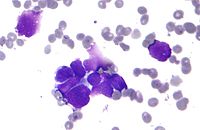
Photo from wikipedia
TFE3 is a member of basic helix-loop-helix leucine zipper MiT transcription factor family and its chimeric proteins are associated with translocation renal cell carcinoma (tRCC). Despite the variety of genes… Click to show full abstract
TFE3 is a member of basic helix-loop-helix leucine zipper MiT transcription factor family and its chimeric proteins are associated with translocation renal cell carcinoma (tRCC). Despite the variety of genes fusions, most of TFE3 fusions partner genes are linked to spliceosome machinery. Dissecting the function of TFE3 fused to spliceosome machinery factors (TFE3-SF) could direct the development of effective therapies for this lethal disease, which is refractory to standard treatments for kidney cancer. Here, by using a combination of in silico structure prediction, molecular cloning, next generation transcriptomics, FRET technology, mutagenesis, proteomics, and high-throughput high-content screening (HTHCS) we interrogated a series of oncogenic mechanisms of TFE3-SF-containing fusions, including spontaneous nuclear translocation, nuclear paraspeckle occupancy, enhanced in vitro proliferation and in vivo growth, transcriptome remodeling, alternative splicing reprogramming, and novel dimer partner recruitment. Molecular inhibition of TFE3-SF dimerization reverses its oncogenic activity and represents a potential new target for therapeutic intervention. By using HTHCS combined with FRET technology we screened FDA approved drugs library (LOPAC) and small molecule library (Microsource) and identified hits compounds which inhibit TFE3-SF dimerization. Hits compounds were validated in 2D and 3D models utilizing patient derived xenolines expressing TFE3-SF. Ouabain and terfenadine demonstrated decreased cell proliferation, reduced spheroid growth and in vivo tumor growth. Overall, our results unmask synthetic vulnerabilities of TFE3-SF dimerization for novel therapeutic strategies in patients with this aggressive type of kidney cancer. Citation Format: Nur Damayanti, Sabrina Orsi, Ricardo Cordova, Christopher Rupert, Li Shen, William Marston Linehan, Kirk Staschke, Peter Hollenhorst, David Heppner, Roberto Pili. A mechanistic study of the TFE3-splicing machinery gene fusions reveals a new druggable target for translocation renal cell carcinoma. [abstract]. In: Proceedings of the American Association for Cancer Research Annual Meeting 2023; Part 1 (Regular and Invited Abstracts); 2023 Apr 14-19; Orlando, FL. Philadelphia (PA): AACR; Cancer Res 2023;83(7_Suppl):Abstract nr 4495.
Journal Title: Cancer Research
Year Published: 2023
Link to full text (if available)
Share on Social Media: Sign Up to like & get
recommendations!